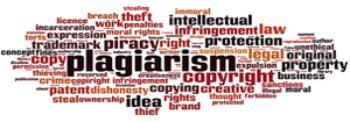Plagiarism, citation and referencing
 An increasingly recognized problem is a tendency amongst students to use someone else’s work without giving credit to the original author by providing a reference. The following statement appears in the COPE Report (1999): “Plagiarism ranges from the unreferenced use of others’ published and unpublished ideas, including research grant applications to submission under ‘new’ authorship of a complete paper, sometimes in a different language. It may occur at any stage of planning, research, writing or publication: it applies to print and electronic versions”. The ease of access to the internet, and download from there, sometimes results in large chunks of text being “lifted” and inserted into an essay, report etc without referencing. This is an unacceptable practice and if detected can result in disciplinary action.
An increasingly recognized problem is a tendency amongst students to use someone else’s work without giving credit to the original author by providing a reference. The following statement appears in the COPE Report (1999): “Plagiarism ranges from the unreferenced use of others’ published and unpublished ideas, including research grant applications to submission under ‘new’ authorship of a complete paper, sometimes in a different language. It may occur at any stage of planning, research, writing or publication: it applies to print and electronic versions”. The ease of access to the internet, and download from there, sometimes results in large chunks of text being “lifted” and inserted into an essay, report etc without referencing. This is an unacceptable practice and if detected can result in disciplinary action.
The rules for citation and referencing are quite simple and will avoid plagiarism: Verbatim duplication of someone else’s work must be enclosed by inverted commas and referenced. Modification (e.g. re-writing) of someone else’s work while still conveying the original author’s concepts always requires referencing. This should go all the way back to the original author and not simply a reference to a review article which itself refers to others’ work. It goes without saying that the original reference must always be read and critically evaluated by the student.
Caution is required with material derived from the Internet as little of this is peer-reviewed, unless from recognised scientific journals. Students should use the Vancouver style of referencing where references are numbered in the text (the number being superscripted or bracketed), with the bibliographic details appearing in numerical order at the end of the text in a section labelled “References”. Footnotes should never be used for referencing and are discouraged as they break up the flow of text. Footnotes are never used in scientific papers to communicate any information of relevance to the main text, which should be self-contained.
The University’s regulation define plagiarism as the submission or presentation of work, in any form, which is not one's own, without acknowledgement of the sources and may include inappropriate collaboration or the re-use of a student’s own previous work. Plagiarism is considered to be an act of fraudulence and an offence against University discipline. The University reserves the right to use plagiarism detection systems in the interests of improving academic standards: https://www.gla.ac.uk/myglasgow/senateoffice/studentcodes/plagiarism/.
At the Medical School we use the anti-plagiarism software Turnitin: https://www.gla.ac.uk/myglasgow/leads/students/plagiarism/usingturnitin/.
Practical Advice about plagiarism
The following tutorial from the University of Leicester will provide some practical advice: https://blackboard.le.ac.uk/bbcswebdav/institution/Student%20Development/Online%20tutorials/Plagiarism/MEDIC/story_html5.html
Students should include and sign the following statement about their written work:
Plagiarism Statement
I am aware of and understand the University’s policy on plagiarism (under "University Fees and General Information for Students" in the University Calendar and certify that this assignment is my own work, except where indicated by referencing, and that I have followed the good academic practices noted below
Signed___________________________________________________________________
Declaration of Originality
I confirm that this assignment is my own work and I have
- Read and understood the guidance on plagiarism in the Undergraduate Handbook, including the University of Glasgow Statement on Plagiarism.
- Clearly referenced, in both the text and the bibliography or references, all sources used in the work.
- Fully referenced (including page numbers) and used inverted commas for all text quoted from books, journals, web etc. (Please check with the Subject which referencing style is to be used).
- Provided the sources for all tables, figures, data etc. that are not my own work.
- Not made use of the work of any other student(s) past or present without acknowledgement. This included any of my own work, that has previously, or concurrently, submitted for assessment, either at this or any other institution, including school.
- Not sought or used the services of any professional agencies to produce this work.
- In addition, I understand that any false claim in respect of this work will result in disciplinary action in accordance with University regulations.

